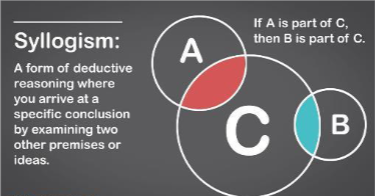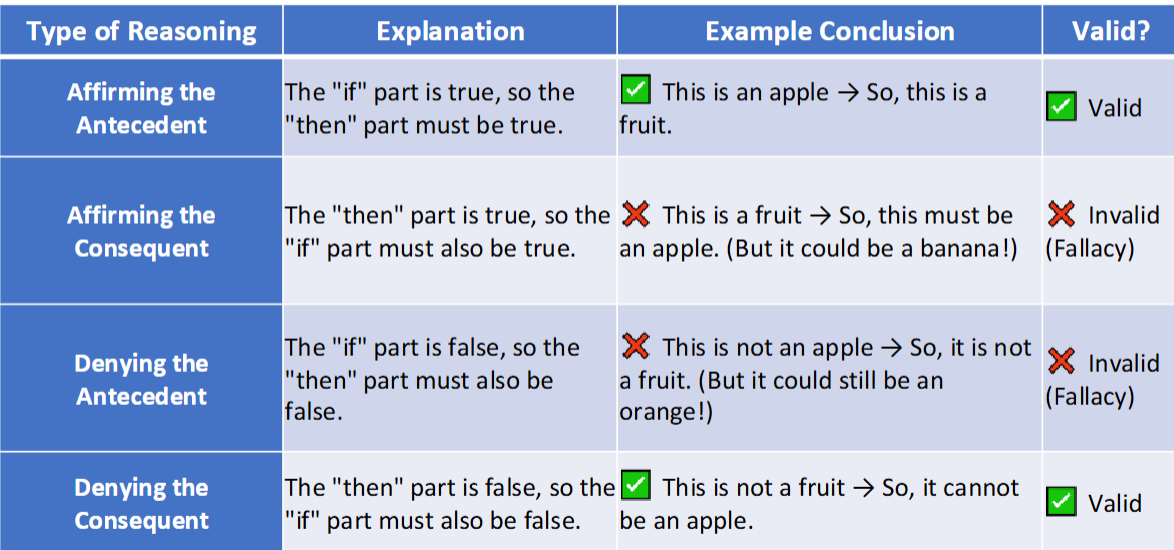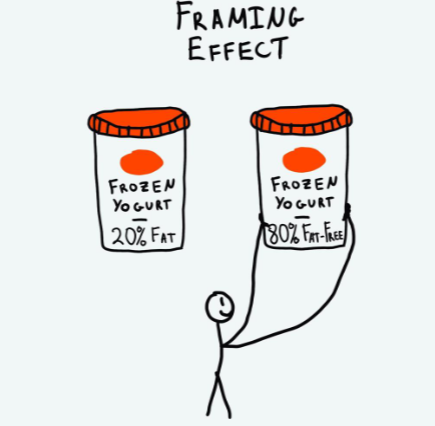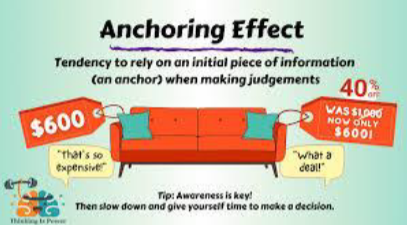Ch. 12 Deductive Reasoning & Decision-Making
1/28
There's no tags or description
Looks like no tags are added yet.
Name | Mastery | Learn | Test | Matching | Spaced |
|---|
No study sessions yet.
29 Terms
Syllogism (2)
A three-part argument
Combines two premises to reach conclusions
Requires a judgment

Four types of reasoning in propositional logic

Type 1 processing (5)
Fast & automatic
More error-prone
Used in every day decision-making
More subconscious
Used during depth perception, recognition of facial expression, automatic stereotyping
Type 2 processing (3)
Relatively slow & controlled (effortful); more reliable
Focused attention -→ typically more accurate
When we acknowledge our Type 1 response may have been incorrect
Illusory correlation
Confidence that two variables are related when the correlation is weak or nonexistent
Framing effect (3)
Outcome of decisions may be influenced by:
Background context of choice
Wording or framing of question

Prospect theory (3)
People tend to think that possible gains are different from possible losses
When dealing with possible gains, people tend to avoid risk
When dealing with possible losses, people tend to seek risks
Conditional/propositional reasoning (3)
Describes the relationship between conditions
Antecedent: first proposition/statement; the “if” part
Consequent: second proposition; the “then” part
Findings of Wason et al. on the Standard Wason Selection task (2)
Found that people show a confirmation bias
People tended to affirm the antecedent → pick E (vowel) card
Base rate (2)
How often the item occurs in the population
Often ignored because of the representativeness heuristic
Base rate fallacy
Emphasizing representativeness and paying too little attention to info about base rate
The “Linda problem”
Traced to the representativeness heuristic
Conjunction fallacy demonstrates how people ignore the most basic principles of probability theory
Availability heuristic
People estimate likelihood of an event based on how easily examples come to mind
Representativeness heuristic
People judge the probability of an event based on how similar it is to a prototype or stereotype
Deductive vs inductive reasoning (2)
Deductive moves from general knowledge and principles to more specific knowledge & examples
Inductive uses specific observations and real examples to infer general theories about the world
Belief bias effect
When people make judgments based on prior beliefs and general knowledge rather than logic
Confirmation bias
Tendency to seek and remember info that confirms existing beliefs
Conjunction rule
The probability of two events happening together in conjunction cannot be higher than probability of either event happening individually
Anchoring effect
When people rely too heavily on an initial piece of information anchor when making decisions and adjust insufficiently from it
Emphasizes top-down processing
Operates similarly for novices and experts

Recognition heuristic
If one of two options is recognized and the other is not, people assume the recognized one has higher value/frequency
Confidence intervals
The range that we expect a number to fall within a certain percentage of the time
Estimates for confidence intervals are usually too narrow → include the correct answer only 60% of the time
Anchoring and adjustment heuristic plays a role in confidence intervals
Ecological rationality
(Todd et al. 2007) Describes how people create a wide a variety of heuristics to help them make useful, adaptive decisions in the real world
Default heuristic
If there is a standard—doing nothing—then people choose that option
My-side bias (2)
Overconfidence that own view is correct in confrontational situations
Emphasize Type 2 processing to reduce my-side bias
Hindsight
Judgments about events that happened in the past
Hindsight bias (4)
We judge an event that happened as inevitable
Reflects overconfidence that we could have predicted the outcome accurately in the past
Stronger for experts in their particular domains
Varies as a function of psychological well-being
Maximizers (3)
Looks for maximum benefit & highest utility
Compare decisions with others
Tendency to regret decisions is higher
Satisficers (3)
Settle for good enough options
Do not bother comparing decisions with others
More satisfied with outcomes
Small-sample fallacy
Assuming a small sample will be representative of the population → can lead to incorrect decisions